Christian houses of worship and their ancillary buildings and spaces are properly understood as communal statements of faith that invite both Christians and non-believers to acknowledge and worship God. When such buildings and spaces are beautiful, durable, and shape and ornament the public realm, they reinforce the faith of Christians, open minds of non-believers to a more sympathetic consideration of Christian truth claims, foreshadow the New Jerusalem as eschatological gift, and participate in the New Jerusalem as sacramental presence. – Phillip Bess
Doth not wisdom cry? and understanding put forth her voice? She stands in the top of high places, by the way in the places of the paths. She cries at the gates, at the entry of the city, at the coming in at the doors. Unto you, O men, I call; and my voice is to the sons of man. O ye simple, understand wisdom: and, ye fools, be ye of an understanding heart. Hear; for I will speak of excellent things; and the opening of my lips shall be right things. For my mouth shall speak truth; and wickedness is an abomination to my lips. Proverbs 8:1-7
We live in an era of exceptional wealth, freedom and technological advancement. But we also live in an era increasingly affected by a deep loss of rooted place and growing alienation, by poor stewardship and exploitation, by a lack of being at home in the world. The current state of individuals and the greater patterns of human dwelling give evidence that there is something amiss with contemporary culture, its moral decline and epistemological uncertainties. The Church is needed in communities more than ever.
We live in an age that is growing more and more skeptical of claims of what is good and what is true. As Christians this has posed problems for evangelizing. It’s become difficult to enter the public dialogue with logical arguments about truth and morality. People have lost faith in objective truth and goodness. And though truth and goodness are important, I would suggest we need to broaden tactics and meet our neighbors where they stand. We need to lead with Beauty in the civil realm. Beauty evokes an intuitive reaction before thought and people see it is good without initially knowing why, without reacting negatively. Beauty puts a foot in the door that lead to conversations of the Truth and Goodness of God, His divine revelation and ultimately His relationship to the created world and its salvation. Beauty has the power to arrest our attention and affect our will before intellectual ponderance. Beauty holds our gaze and seduces us in noble ways long enough to see God made manifest and incarnated into our world of Being. This is important because Beauty is objective and not a matter of personal preference. It confronts you and demands a response to its call. Beauty elects you, it chases you down, it shatters your receptivity and conceptualizing schema, it draws you out of yourself and into wonder and afterward Beauty sends you out to tell others. Yet, even though beauty confronts us as an impression, it nonetheless can be analyzed. There are objective criteria if we dig past the surface of a beautiful object. Beauty can be described. In fact, the Beautiful calls us to meditate, to value its wholeness, understand its inner relations and appreciate its wonder.
Thomas Aquinas’s theory of beauty can be helpful in defining the objectivity of beauty. He focuses on three key elements: integrity, proportion, and clarity. Together, these elements form Aquinas’s triad of beauty, providing a philosophical framework for understanding and appreciating aesthetic qualities in various forms. Integrity refers to the completeness or wholeness of a thing. According to Aquinas, a beautiful object must possess unity and coherence, where all its parts contribute harmoniously to the overall composition. A beautiful church maintains a sense of completeness and unity in its architecture, design, and purpose. This includes the harmonious integration of various elements, such as the layout, decorations, and symbols, contributing to a unified and meaningful whole. Secondly, proportion involves the balanced relationship between various elements, ensuring that they are in proper measure and harmony. Proportion contributes to the aesthetic appeal and symmetry of an object. The architectural and artistic elements of a church should exhibit proportion and balance. The size and arrangement of spaces, windows, sculptures, and other features should be carefully considered to create a visually pleasing and harmonious environment.
Lastly, clarity, or radiance points to the luminosity or brightness that enhances the perceptibility of an object. The clearer an object is, the more it allows its form and structure to be apprehended, adding to its beauty. A beautiful church allows for the clarity of form and purpose. This involves the use of light, symbolism, and design elements to enhance visibility and illuminate the sacred aspects, enabling believers and unbelievers to better understand and connect with the spiritual significance.
The actuality of Beauty is the idea that Beauty is not merely a potential quality but an actual, realized aspect of an object. In other words, beauty is not just a subjective perception or a latent potential; it is something that is actively present and observable.
According to Aquinas, the actuality of beauty is grounded in the inherent qualities of an object. When an object possesses qualities such as integrity, proportion, and clarity, these qualities actualize the beauty of the object. It implies that beauty is not solely dependent on individual preferences but has objective qualities that manifest and contribute to the aesthetic experience. By incorporating these principles, a church can actualize beauty, creating an environment that inspires a sense of reverence, contemplation, and aesthetic appreciation.
The rose window of the north façade of the cathedral of Notre Dame is a good example.
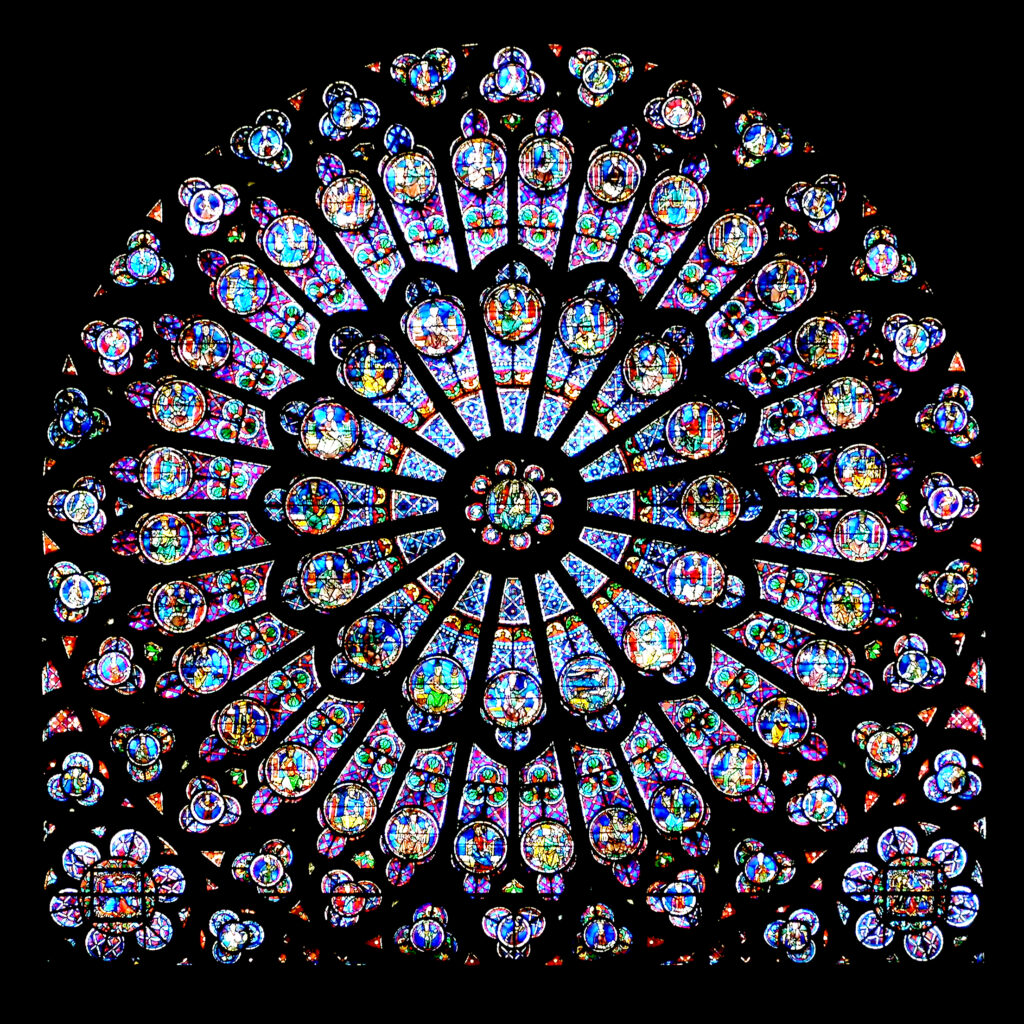
The north window of the cathedral of Notre Dame
Pictured above it shows the circle of the window, a symbol of universal perfection, as structurally complete with strength and massing to form a whole where the spokes are neither too thick to be bulky or to thin to be spindly. Nothing could be added or taken away without compromising the integrity of the whole. Its dynamic circular rhythm creates a complete composition. Furthermore, the parts relate to the whole. There is a harmony between the circle of the rose window and its minor order of windows. At the center is Christ with the Virgin Mary Radiating from the center are concentric rings of circles proportionate the total arrangement. Far from being arbitrary, even the particular windows form a complete story with the 64 outer circles reflecting the lives of the saints, the 32 middle circles illuminating the lives of the prophets and the 8 central windows of lilies circumscribing the virgin and child. Together they add up to 88 individual windows playing on the number 8, a reference to the eternity of covenantal history. Lastly, the windows shine forth and mediate the glory of God, illuminating His eternal presence and filling both believer and unbeliever with awe and wonder. It makes us stand back and say, “Now that’s a window!”
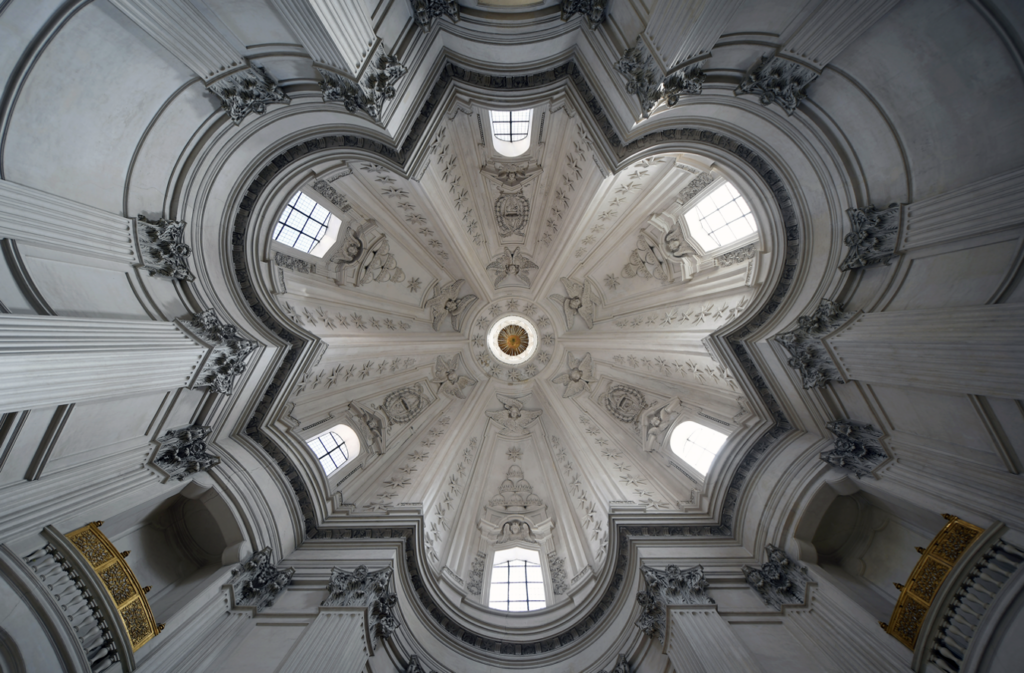
Fig. 2 Dome of Sant. Ivo all Sapienza in Rome
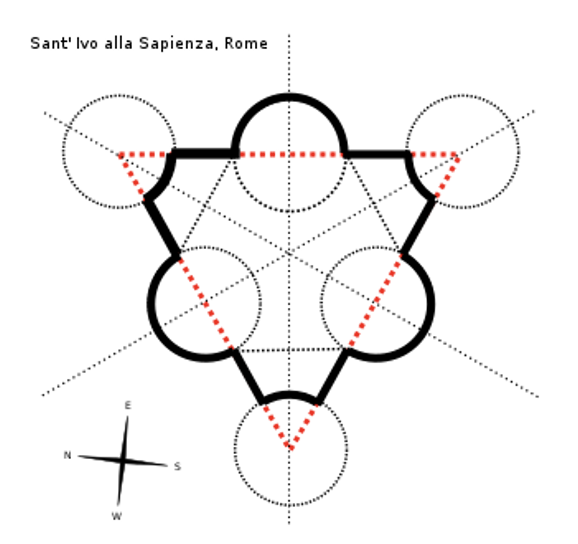
Fig. 3 Geometry of the Floor Plan of Sant. Ivo alla Sapienza in Rome
St. Ivo alla Sapienza in Rome is a church attached to a library. Borromini conceived of the plan as a play on the Solomonic star of wisdom by superimposing two triangles upon each other and alternating convex and concave subtractions to the points of the star. The whole of the church is integrated with this form and the parts that make up the whole likewise do so in harmony with each of the other members: the plan, the columns, the dome and even the descending dove are proportioned to reinforce the whole of the form. Finally, the clear splendor of the composition is sublime and overtakes the senses. Its use of form, structure and symbol coupled with the radiance of light illuminate the sacred nature of the space.
How can we build a church today to express beauty? A church expresses beauty through various means, encompassing both its physical aspects and the intangible elements of its purpose and community. Through architectural design the physical structure of a church, including its design, symmetry, and details, can convey beauty. Architectural elements such as stained-glass windows, arches, and spires contribute to the aesthetic appeal. Another way is through art and decoration. Churches often feature art, sculptures, paintings, and other decorations that depict religious themes, saints, and biblical stories. These artistic elements contribute to the radiance of the church interior and exterior. Symbolism and meaning convey beauty in a church and is often expressed through the symbolic significance of its elements. Religious symbols, colors, and rituals convey deeper meanings that enhance the spiritual experience of the believer and unbeliever. The use of music, hymns, and liturgical practices adds an auditory dimension to the church’s beauty. Harmonious melodies and meaningful rituals contribute to the overall aesthetic experience and often bleed out into the community around it. The celebration of sacraments and rituals within the church provides a sense of sacred beauty. Baptisms, weddings, and other ceremonies add layers of meaning and richness to the public realm and are great manifestations of human interaction.
Another way beauty can be expressed is by incorporating natural light, gardens and green spaces, loggias and courtyards to enhance the beauty of a church while also providing itself as a gift to the community for public use. Connecting with nature within the church environment can evoke a sense of tranquility and contemplation. All these expressions of the beauty of a church should of course extend beyond its physical appearance. A welcoming and hospitable community that practices love, compassion, and service contributes to the real beauty of the Church. This is integrity, proportion and clarity conjoining both the Church and the church building.
Why should the church be built durably and beautifully? Though not exhaustive, here are four reasons we should build durably and beautifully. First and foremost, it is a testimony of the kingdom of God not yet realized but which truly is. It is a kingdom without end where the gates of hell will not prevail. A church that is durable and built well instills this sense of permanence and points toward the eternal city yet to come. The Church is the actual body of Christ, and a church building is an icon of that reality. It symbolizes the body of Christ in material and symbolic form and as such it should reflect its inhabitants. The beauty of Christ is made manifest in brick and stone, glass and sheetrock to the extent that God has given a church its means.
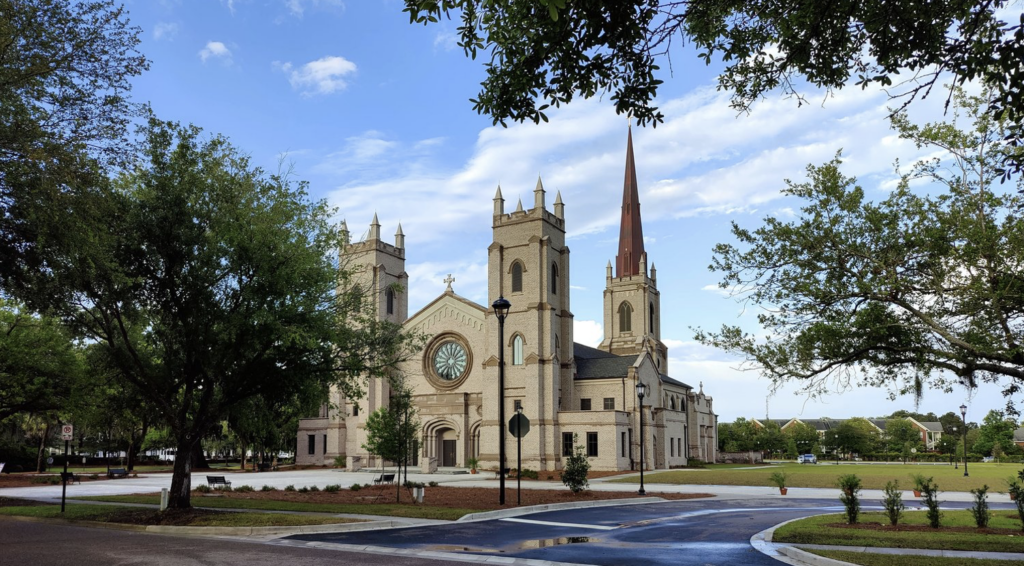
Phase 1 of St. Clare of Assisi in Daniel Island, SC completed 2023
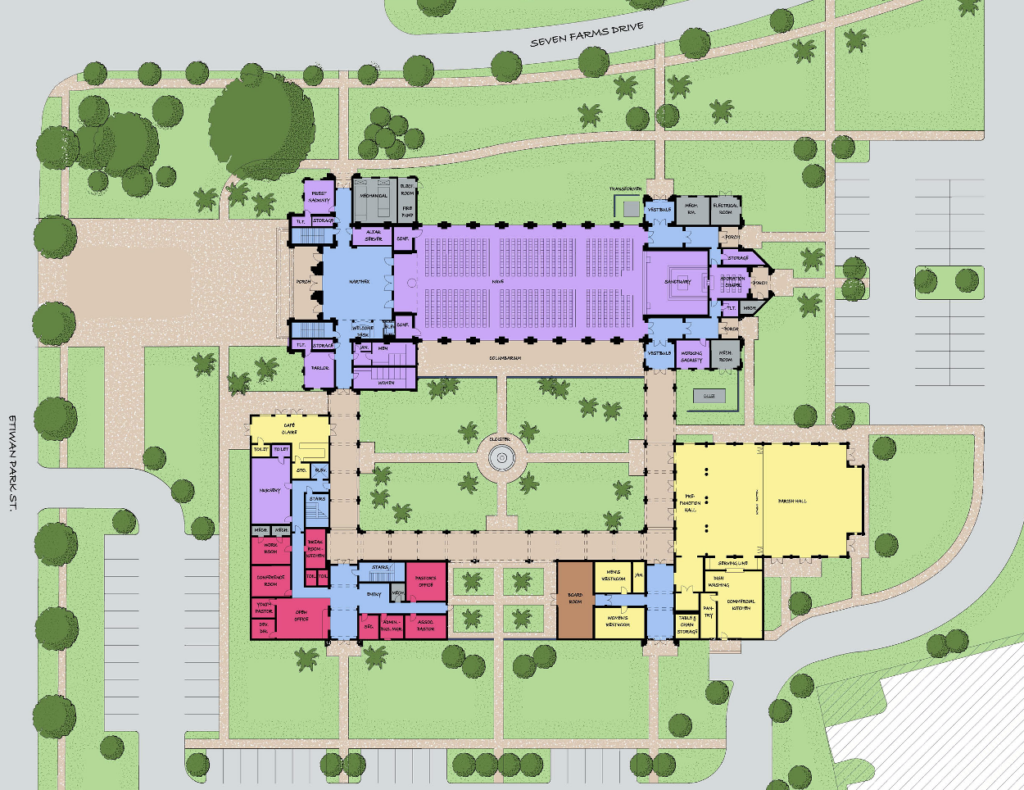
Site Plan of St. Clare of Assisi
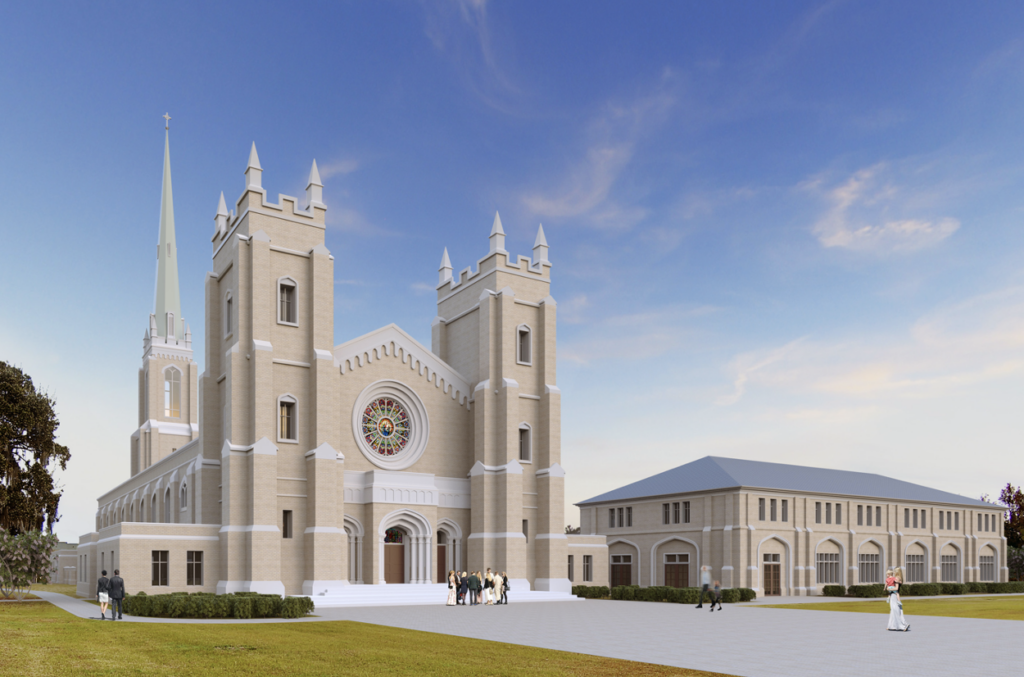
Proposed Phase 2 of St. Clare of Assisi
An example of this is the new worship building for St. Clare of Assisi which was consecrated in March 2023 in a small traditional community on Daniel Island. During the dedication service it was called upon to be a light set on a hill that could not be hid. Its gothic inspired form looks like it has been there for a thousand years. Its brick and stone façade stands nobly in the community. Its stained glass pushes against the darkness of night to show the gospel found within. The majestic towers point the eye upward to the eternal. The bells toll to remind us to redeem the time; to teach us to number our days so that our hearts may know wisdom.
Second, churches should instill a sense of transcendence in the community it serves by being timeless buildings and institutions of grace. The ministry of the church ought to present itself as a microcosm of a heavenly reality. I have always appreciated the importance Phillip Bess places on the church in community and I appreciate both projects presented that encourage development around a religious place in the community. It is a symbiotic relationship: Churches need dense and immediate communities to minister to and an arena to proclaim the gospel while communities need strong religious institutions to give it a center, purpose, and meaning, A church stands as a bold witness to a community both of believers and non-believers and confronts people with the power, transcendence and awe of the gospel made visible in stone. From its doors children are cared for, the homeless are fed, the widow is protected. Its beauty ought to testify of a God that is good and who has condescended to encounter us in our daily lives. To this end churches are often accompanied by other institutions such as places of education, travel inns, foundling homes and orphanages, soup kitchens and elderly care facilities. Far from being a place for only Sunday worship and sparse administration during the week, a church should strive to be a vibrant center of 24/7 activity that presents the gift of God dwelling with us.
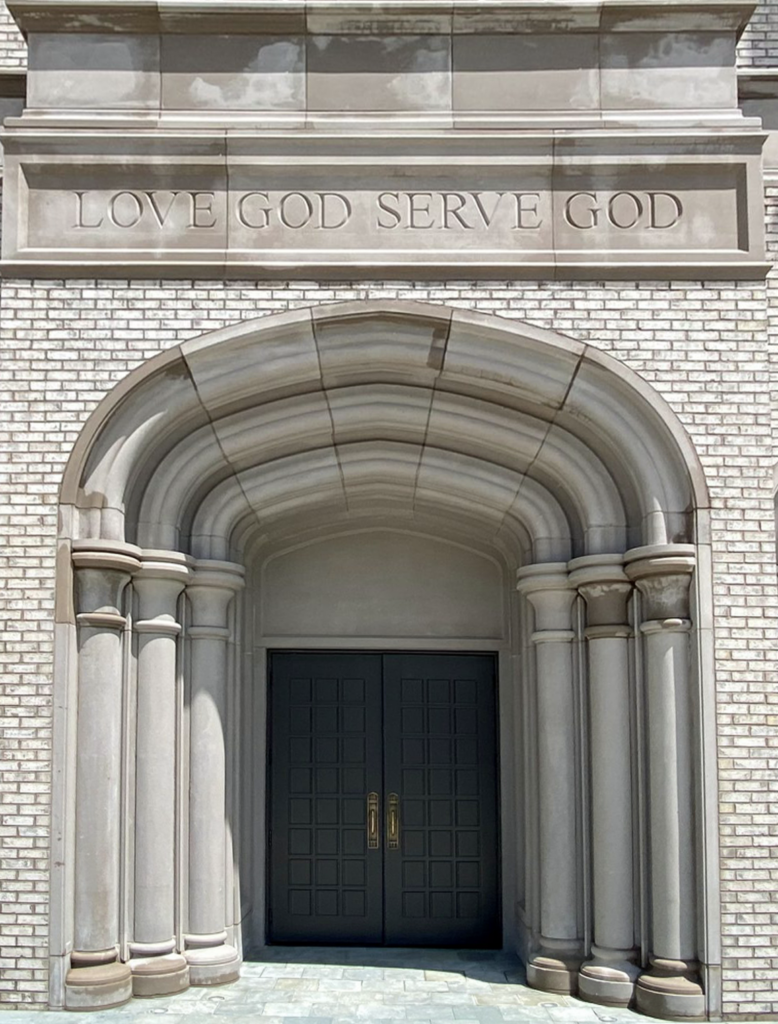
St. Clare of Assisi Main Entry
Third, a durable and beautiful church reinforces the stewardship of creation. The world created is good and is a gift to mankind. No one can argue, for example, that Chartres cathedral isn’t a sustainable building. It’s almost a thousand years old. In fact, it is an example par excellence of good stewardship built both materially well and beautiful. The latter quality is overlooked by many contemporary architects: only buildings that are loved are preserved. Churches have the opportunity to lead the discussion about sustainable/ green architecture and to become a role model for the community to emulate. I tell churches that they should measure the life cycle of a building in terms of centuries not decades. St. Clare was built with this in mind both materially and spiritually. Building for decades is the unfortunate model of commercial development and is driven by profit, greed and avarice. It does not view the world generationally as something to be bestowed upon others. In contrast, the church sees the world through the lens of God’s work and His mandate of dominion and stewardship.
Lastly, a beautiful and durable church can create meaningful public space. Not only does it ‘address’ the civil realm with dignity and civility, but the arrangement of buildings can also allow for public spaces to be constructed – exterior spaces that draw in the passerby. These public spaces become gifts to the city. Public squares, semi-cloistered courtyards and gardens alike are offered to all who wish to enjoy them. Weddings spill out on to these public squares, green spaces provide a reprieve from the business of the world around it, festivals are celebrated, public debates are held, markets are made; these are just a few activities the public enjoys in the shadow of the church. Churches offer the theatre for cultural generation and regeneration.
A church building is a symbol of the preserving power of the Church in community and its beauty can be a powerful means to enter the public discourse of a generation distrustful of truth claims. So, while Beauty is objective, it also has an intuitive component that opens the mind for truths that might otherwise be rejected out of hand. We are called to be to salt on the earth and a means God can use to stem the tide of moral decay. This involves promoting ethical behavior, justice, and compassion in the community, while also providing institutions capable of affecting the hearts and minds of people in spiritual way; leading people to desire the Beautiful, the Good and the True. The church building should symbolize the proclaiming power of the Church. Far from being another voice in the cacophony of relative discourse, the church must stand with intellectual and moral steadfastness as it has throughout history when it has been a sanctifying means of grace and a well-spring of cultural blessings to the communities it served. The beauty of our churches can be a means of interrupting the polemic of current nihilism and instead show a better and more glorious way that leads toward the New Jerusalem.
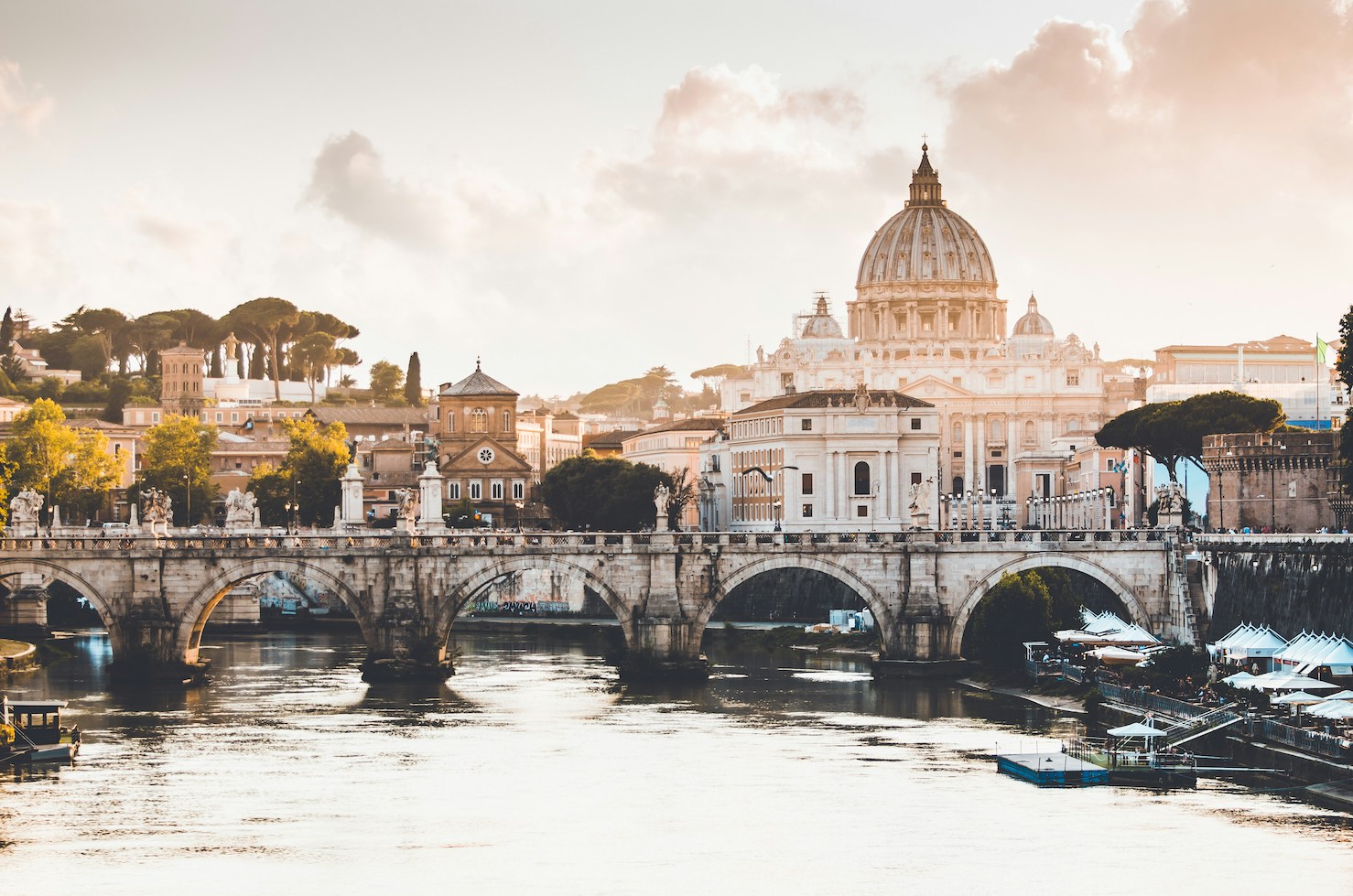
Christian houses of worship and their ancillary buildings and spaces are properly understood as communal statements of faith that invite both Christians and non-believers to acknowledge and worship God. When such buildings and spaces are beautiful, durable, and shape and ornament the public realm, they reinforce the faith of Christians, open minds of non-believers to a more sympathetic consideration of Christian truth claims, foreshadow the New Jerusalem as eschatological gift, and participate in the New Jerusalem as sacramental presence. – Phillip Bess
Doth not wisdom cry? and understanding put forth her voice? She stands in the top of high places, by the way in the places of the paths. She cries at the gates, at the entry of the city, at the coming in at the doors. Unto you, O men, I call; and my voice is to the sons of man. O ye simple, understand wisdom: and, ye fools, be ye of an understanding heart. Hear; for I will speak of excellent things; and the opening of my lips shall be right things. For my mouth shall speak truth; and wickedness is an abomination to my lips. Proverbs 8:1-7
We live in an era of exceptional wealth, freedom and technological advancement. But we also live in an era increasingly affected by a deep loss of rooted place and growing alienation, by poor stewardship and exploitation, by a lack of being at home in the world. The current state of individuals and the greater patterns of human dwelling give evidence that there is something amiss with contemporary culture, its moral decline and epistemological uncertainties. The Church is needed in communities more than ever.
We live in an age that is growing more and more skeptical of claims of what is good and what is true. As Christians this has posed problems for evangelizing. It’s become difficult to enter the public dialogue with logical arguments about truth and morality. People have lost faith in objective truth and goodness. And though truth and goodness are important, I would suggest we need to broaden tactics and meet our neighbors where they stand. We need to lead with Beauty in the civil realm. Beauty evokes an intuitive reaction before thought and people see it is good without initially knowing why, without reacting negatively. Beauty puts a foot in the door that lead to conversations of the Truth and Goodness of God, His divine revelation and ultimately His relationship to the created world and its salvation. Beauty has the power to arrest our attention and affect our will before intellectual ponderance. Beauty holds our gaze and seduces us in noble ways long enough to see God made manifest and incarnated into our world of Being. This is important because Beauty is objective and not a matter of personal preference. It confronts you and demands a response to its call. Beauty elects you, it chases you down, it shatters your receptivity and conceptualizing schema, it draws you out of yourself and into wonder and afterward Beauty sends you out to tell others. Yet, even though beauty confronts us as an impression, it nonetheless can be analyzed. There are objective criteria if we dig past the surface of a beautiful object. Beauty can be described. In fact, the Beautiful calls us to meditate, to value its wholeness, understand its inner relations and appreciate its wonder.
Thomas Aquinas's theory of beauty can be helpful in defining the objectivity of beauty. He focuses on three key elements: integrity, proportion, and clarity. Together, these elements form Aquinas's triad of beauty, providing a philosophical framework for understanding and appreciating aesthetic qualities in various forms. Integrity refers to the completeness or wholeness of a thing. According to Aquinas, a beautiful object must possess unity and coherence, where all its parts contribute harmoniously to the overall composition. A beautiful church maintains a sense of completeness and unity in its architecture, design, and purpose. This includes the harmonious integration of various elements, such as the layout, decorations, and symbols, contributing to a unified and meaningful whole. Secondly, proportion involves the balanced relationship between various elements, ensuring that they are in proper measure and harmony. Proportion contributes to the aesthetic appeal and symmetry of an object. The architectural and artistic elements of a church should exhibit proportion and balance. The size and arrangement of spaces, windows, sculptures, and other features should be carefully considered to create a visually pleasing and harmonious environment.
Lastly, clarity, or radiance points to the luminosity or brightness that enhances the perceptibility of an object. The clearer an object is, the more it allows its form and structure to be apprehended, adding to its beauty. A beautiful church allows for the clarity of form and purpose. This involves the use of light, symbolism, and design elements to enhance visibility and illuminate the sacred aspects, enabling believers and unbelievers to better understand and connect with the spiritual significance.
The actuality of Beauty is the idea that Beauty is not merely a potential quality but an actual, realized aspect of an object. In other words, beauty is not just a subjective perception or a latent potential; it is something that is actively present and observable.
According to Aquinas, the actuality of beauty is grounded in the inherent qualities of an object. When an object possesses qualities such as integrity, proportion, and clarity, these qualities actualize the beauty of the object. It implies that beauty is not solely dependent on individual preferences but has objective qualities that manifest and contribute to the aesthetic experience. By incorporating these principles, a church can actualize beauty, creating an environment that inspires a sense of reverence, contemplation, and aesthetic appreciation.
The rose window of the north façade of the cathedral of Notre Dame is a good example.

The north window of the cathedral of Notre Dame
Pictured above it shows the circle of the window, a symbol of universal perfection, as structurally complete with strength and massing to form a whole where the spokes are neither too thick to be bulky or to thin to be spindly. Nothing could be added or taken away without compromising the integrity of the whole. Its dynamic circular rhythm creates a complete composition. Furthermore, the parts relate to the whole. There is a harmony between the circle of the rose window and its minor order of windows. At the center is Christ with the Virgin Mary Radiating from the center are concentric rings of circles proportionate the total arrangement. Far from being arbitrary, even the particular windows form a complete story with the 64 outer circles reflecting the lives of the saints, the 32 middle circles illuminating the lives of the prophets and the 8 central windows of lilies circumscribing the virgin and child. Together they add up to 88 individual windows playing on the number 8, a reference to the eternity of covenantal history. Lastly, the windows shine forth and mediate the glory of God, illuminating His eternal presence and filling both believer and unbeliever with awe and wonder. It makes us stand back and say, “Now that’s a window!”

Fig. 2 Dome of Sant. Ivo all Sapienza in Rome

Fig. 3 Geometry of the Floor Plan of Sant. Ivo alla Sapienza in Rome
St. Ivo alla Sapienza in Rome is a church attached to a library. Borromini conceived of the plan as a play on the Solomonic star of wisdom by superimposing two triangles upon each other and alternating convex and concave subtractions to the points of the star. The whole of the church is integrated with this form and the parts that make up the whole likewise do so in harmony with each of the other members: the plan, the columns, the dome and even the descending dove are proportioned to reinforce the whole of the form. Finally, the clear splendor of the composition is sublime and overtakes the senses. Its use of form, structure and symbol coupled with the radiance of light illuminate the sacred nature of the space.
How can we build a church today to express beauty? A church expresses beauty through various means, encompassing both its physical aspects and the intangible elements of its purpose and community. Through architectural design the physical structure of a church, including its design, symmetry, and details, can convey beauty. Architectural elements such as stained-glass windows, arches, and spires contribute to the aesthetic appeal. Another way is through art and decoration. Churches often feature art, sculptures, paintings, and other decorations that depict religious themes, saints, and biblical stories. These artistic elements contribute to the radiance of the church interior and exterior. Symbolism and meaning convey beauty in a church and is often expressed through the symbolic significance of its elements. Religious symbols, colors, and rituals convey deeper meanings that enhance the spiritual experience of the believer and unbeliever. The use of music, hymns, and liturgical practices adds an auditory dimension to the church's beauty. Harmonious melodies and meaningful rituals contribute to the overall aesthetic experience and often bleed out into the community around it. The celebration of sacraments and rituals within the church provides a sense of sacred beauty. Baptisms, weddings, and other ceremonies add layers of meaning and richness to the public realm and are great manifestations of human interaction.
Another way beauty can be expressed is by incorporating natural light, gardens and green spaces, loggias and courtyards to enhance the beauty of a church while also providing itself as a gift to the community for public use. Connecting with nature within the church environment can evoke a sense of tranquility and contemplation. All these expressions of the beauty of a church should of course extend beyond its physical appearance. A welcoming and hospitable community that practices love, compassion, and service contributes to the real beauty of the Church. This is integrity, proportion and clarity conjoining both the Church and the church building.
Why should the church be built durably and beautifully? Though not exhaustive, here are four reasons we should build durably and beautifully. First and foremost, it is a testimony of the kingdom of God not yet realized but which truly is. It is a kingdom without end where the gates of hell will not prevail. A church that is durable and built well instills this sense of permanence and points toward the eternal city yet to come. The Church is the actual body of Christ, and a church building is an icon of that reality. It symbolizes the body of Christ in material and symbolic form and as such it should reflect its inhabitants. The beauty of Christ is made manifest in brick and stone, glass and sheetrock to the extent that God has given a church its means.

Phase 1 of St. Clare of Assisi in Daniel Island, SC completed 2023

Site Plan of St. Clare of Assisi

Proposed Phase 2 of St. Clare of Assisi
An example of this is the new worship building for St. Clare of Assisi which was consecrated in March 2023 in a small traditional community on Daniel Island. During the dedication service it was called upon to be a light set on a hill that could not be hid. Its gothic inspired form looks like it has been there for a thousand years. Its brick and stone façade stands nobly in the community. Its stained glass pushes against the darkness of night to show the gospel found within. The majestic towers point the eye upward to the eternal. The bells toll to remind us to redeem the time; to teach us to number our days so that our hearts may know wisdom.
Second, churches should instill a sense of transcendence in the community it serves by being timeless buildings and institutions of grace. The ministry of the church ought to present itself as a microcosm of a heavenly reality. I have always appreciated the importance Phillip Bess places on the church in community and I appreciate both projects presented that encourage development around a religious place in the community. It is a symbiotic relationship: Churches need dense and immediate communities to minister to and an arena to proclaim the gospel while communities need strong religious institutions to give it a center, purpose, and meaning, A church stands as a bold witness to a community both of believers and non-believers and confronts people with the power, transcendence and awe of the gospel made visible in stone. From its doors children are cared for, the homeless are fed, the widow is protected. Its beauty ought to testify of a God that is good and who has condescended to encounter us in our daily lives. To this end churches are often accompanied by other institutions such as places of education, travel inns, foundling homes and orphanages, soup kitchens and elderly care facilities. Far from being a place for only Sunday worship and sparse administration during the week, a church should strive to be a vibrant center of 24/7 activity that presents the gift of God dwelling with us.

St. Clare of Assisi Main Entry
Third, a durable and beautiful church reinforces the stewardship of creation. The world created is good and is a gift to mankind. No one can argue, for example, that Chartres cathedral isn’t a sustainable building. It’s almost a thousand years old. In fact, it is an example par excellence of good stewardship built both materially well and beautiful. The latter quality is overlooked by many contemporary architects: only buildings that are loved are preserved. Churches have the opportunity to lead the discussion about sustainable/ green architecture and to become a role model for the community to emulate. I tell churches that they should measure the life cycle of a building in terms of centuries not decades. St. Clare was built with this in mind both materially and spiritually. Building for decades is the unfortunate model of commercial development and is driven by profit, greed and avarice. It does not view the world generationally as something to be bestowed upon others. In contrast, the church sees the world through the lens of God’s work and His mandate of dominion and stewardship.
Lastly, a beautiful and durable church can create meaningful public space. Not only does it ‘address’ the civil realm with dignity and civility, but the arrangement of buildings can also allow for public spaces to be constructed - exterior spaces that draw in the passerby. These public spaces become gifts to the city. Public squares, semi-cloistered courtyards and gardens alike are offered to all who wish to enjoy them. Weddings spill out on to these public squares, green spaces provide a reprieve from the business of the world around it, festivals are celebrated, public debates are held, markets are made; these are just a few activities the public enjoys in the shadow of the church. Churches offer the theatre for cultural generation and regeneration.
A church building is a symbol of the preserving power of the Church in community and its beauty can be a powerful means to enter the public discourse of a generation distrustful of truth claims. So, while Beauty is objective, it also has an intuitive component that opens the mind for truths that might otherwise be rejected out of hand. We are called to be to salt on the earth and a means God can use to stem the tide of moral decay. This involves promoting ethical behavior, justice, and compassion in the community, while also providing institutions capable of affecting the hearts and minds of people in spiritual way; leading people to desire the Beautiful, the Good and the True. The church building should symbolize the proclaiming power of the Church. Far from being another voice in the cacophony of relative discourse, the church must stand with intellectual and moral steadfastness as it has throughout history when it has been a sanctifying means of grace and a well-spring of cultural blessings to the communities it served. The beauty of our churches can be a means of interrupting the polemic of current nihilism and instead show a better and more glorious way that leads toward the New Jerusalem.
-->